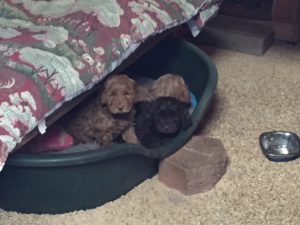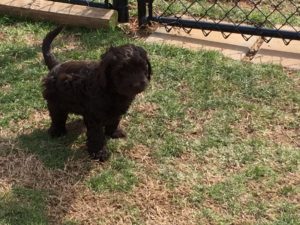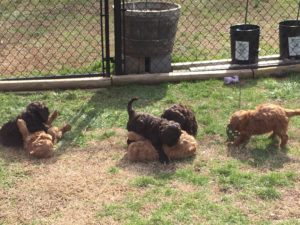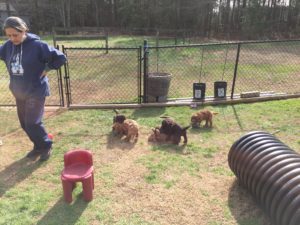When CPT designs a client’s service dog program the first step is a Phase I- Introductory Meeting. During the Meeting, we: a) obtain medical details regarding the recipient’s disability, b) discuss the limitations and effects posed by the disability, c) outline the overall goals and objectives of the program, d) specify the behaviors requested of the dog, so that the dog provides the greatest benefit to the recipient, e) design customized specifications that describe the ideal dog for the client’s program, f) answer remaining client questions, g) develop timelines and milestones for the program, and h) evaluate a candidate animal, should the client already possess an animal he/she is considering for the program.

Yet, despite the inclusion of “h,” the majority of service dog clients do not already own a suitable animal. Moreover, the majority of pet dogs are not suitable as service dog prospects.
A service dog must remain calm, composed, confident, cooperative, and focused on task, regardless of the environment. That means regardless of whether the environment is indoors or outdoors, regardless of the temperature or weather conditions, regardless of the floor or ground substrates, and regardless of noises, vehicles, persons, crowds, dogs, cats, or wildlife present in the environment. A service dog must have outstanding impulse control, an energy level appropriate for the specific service role, and never exhibit out of context excitability, anxiety, or aggression. In addition, the service dog candidate must have outstanding aptitude for the specific assistance tasks and behaviors and must not show salient independence or dominance, whereby the dog may not reliably perform for a disabled handler. When you consider all the above criteria, you will quickly see why it is a rare dog that has the innate gifts to become a supreme service animal.

Consequently, an adroit dog or litter evaluation becomes essential to the ultimate success of a top-notch service dog program. Just like with an NBA or NFL team that to stay on top must excel at drafting the right collegiate talent, a CPT dog or litter evaluator must select the right adult animal or puppy. Otherwise, the effects of coaching/training become minimized. If a professional team drafts substandard athletes, they won’t win a championship, regardless of the quality of coaching. However, if they draft LeBron James, Steph Curry, Tim Duncan, Peyton Manning, or Tom Brady and combine the talent with outstanding coaching, then the result is superlative.
Likewise, if a CPT Trainer works with a service dog candidate that is less than optimal, then the probability is much lower that the program will satisfy all client objectives, despite the high caliber of CPT’s training staff. On the other hand, if a CPT Trainer works with an optimal candidate, then the result is a joyous client whose quality of life is vastly improved from the relationship he/she develops with a wonderfully trained CPT service animal.
Therefore, to reach all subsequent goals, it is imperative that we succeed during the Evaluation and Selection Phase of the program. Fortunately, CPT has incomparable evaluation services that employ validated industry-accepted methods, along with aspects proprietary to CPT. The fused methodologies create the highest probability that a CPT evaluation will select the correct candidate.

Adult dog and litter evaluations are very similar. However, there are some important age-appropriate differences. With an adult dog, usually we don’t have the opportunity to evaluate family members. However, with puppies, we can usually observe one or both parents and all littermates to determine general genetic strengths or proclivities. Adult dog evaluations often exclude certain handling-tolerance tests that are safe with a puppy, but that may pose risk with an older animal. On the other hand, adult dog evaluations usually include more environmental tolerance tests and may include a one-week conditional period for longer-term observation of temperament and household manners. Whereas, we care how easily a puppy adapts to indoor housebreaking and chewing protocols, we insist that an adult dog arrive reliably housebroken and not exhibit any inappropriate chewing behavior or any other unacceptable household manners behavior, including barking, jumping, digging, raiding trash, stealing food, stealing objects, mouthing, or chasing the cat. In addition, an adult dog must demonstrate excellent car manners. With a puppy we will train a blank slate. Therefore, when evaluating a puppy we principally wish to observe an ideal overall temperament and training aptitude. In contrast, with an adult dog we wish to observe the preceding, but also need to ensure that the dog does not present any undesirable household habits or social behaviors that may be difficult to extinguish.
As discussed above, CPT dog and litter evaluations are indispensable when undertaking a service dog program. However, professional evaluations are not just for service dog programs. CPT also highly recommends professional dog or litter evaluations for prospective pet owners.
People will date a prospective spouse for many months or even multiple years before determining “He/she is for me.” Yet, they too often impulsively take home a puppy or dog from the shelter or breeder without conducting equivalent research, even though they will similarly share their home with the animal.

Lack of pre-adoption or pre-purchase due diligence is a major reason why many animals are returned to the shelter and why many people spend excessive monies on behavioral training. Resultantly, pet owners feel guilty when divorcing an animal or feel frustrated living with an animal that is incompatible with their home or lifestyle and where they feel forced to spend excessive monies on “counseling.” Either alternative may permanently affect a person’s attitude toward the pet owning experience. However, if they schedule a professional evaluation prior to completing the adoption or purchase, they will maximize the probability that their human-animal relationship will last happily until “death do us part.”
In closing, we wish to thank Carol Dean of Southern Charm Labradoodles for allowing us to display photographs of a recent litter evaluation. The evaluation was highly successful. We selected a puppy, later named Winston, that we are training as a service dog for a client family in Texas, where the teenage daughter suffers from seizure disorder and complex regional pain syndrome.

The above video shows additional toys and obstacles that aid the puppies’ sensory development and environmental conditioning.
© Copyright Mark Spivak and Comprehensive Pet Therapy, Inc. January 2016. Revised August 2016. All rights reserved.